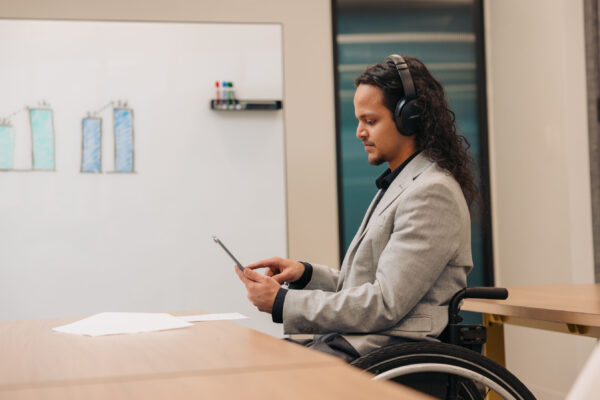The Power of Employee Resource Group (ERG)s: Enhancing and Inclusion at Work
Employee Resource Group (ERG)s are a powerful way to foster inclusivity, build community, and while you’re at it even advance your career.
What is an Employee Resource Group (ERG)?
An Employee Resource Group (ERG) is a voluntary, employee-led organization that brings together individuals with shared identities or experiences. ERGs are typically supported by the company, often with executive sponsorship and funding, and they play a key role in promoting diversity, equity, and inclusion (DEI).
Disability ERGs focus on supporting employees with disabilities and chronic illnesses, as well as allies who want to advocate for accessibility and inclusion in the workplace. They provide a safe space for discussion, education, and policy advocacy while also helping businesses become more inclusive, accessible and perhaps even expand their markets.
Why Employee Resource Group (ERG)s Matter: Benefits for Employees and Companies
1. Promoting an Inclusive Workplace Culture
ERGs help drive a culture where employees with disabilities feel valued, supported, and empowered to bring their full selves to work. These groups work to:
• Increase awareness and understanding of disability-related challenges
• Advocate for better workplace accommodations and accessibility
• Encourage open conversations about disability and inclusion
• Help managers and HR implement inclusive policies
For companies, a disability ERG will improve workplace culture by fostering belonging, engagement, and retention all of which contribute to higher job satisfaction and productivity.
2. Building a Stronger Community
Employees with disabilities often face barriers to inclusion, and connecting with others who share similar experiences can be incredibly empowering. A Disability ERG will provide:
• A support network for employees navigating disability in the workplace
• A space for mentorship and peer guidance
• Opportunities to share best practices for managing disabilities at work
• A way to educate allies and leadership about disability inclusion
For employees who may not feel comfortable disclosing their disability openly, ERGs offer a confidential and understanding environment to connect and seek support.
3. Driving Career Growth and Leadership Opportunities
Beyond community and advocacy, ERGs can be a strategic tool for career advancement. Participating in or leading an ERG provides valuable opportunities to:
• Gain visibility with senior leadership by working on high-profile initiatives
• Develop leadership skills by organizing events, managing projects, and leading discussions
• Showcase strategic thinking in areas like diversity and business impact
• Build cross-departmental connections and expand your professional network
For MS professionals looking to grow within their company, ERG involvement demonstrates initiative, leadership, and commitment to fostering an inclusive workplace.
Joining an Existing ERG
If your company already has a disability focused ERG, getting involved is a great first step. You can:
• Attend meetings and events to connect with like-minded colleagues
• Volunteer to help with initiatives that promote disability inclusion
• Advocate for specific workplace improvements, such as accessibility upgrades or inclusive hiring practices
• Educate others by sharing your experiences and expertise
Key steps to starting a Disability ERG
If your company doesn’t have a disability ERG, you can be the catalyst for change. Here’s how to get started:
1. Assess interest – Reach out to colleagues with disabilities and allies who may be interested in forming a group.
2. Secure leadership support – Identify an executive sponsor who can help advocate for and fund the ERG. If you work for an inclusive company it shouldn’t be a tough sell.
3. Define your mission and goals – Will the ERG focus on support, education, advocacy, or all three?
4. Make the business case – Highlight how a disability ERG aligns with company goals, improves workplace culture, and possibly expand markets.
5. Launch with an action plan – Host a kickoff meeting, set up regular discussions, and start driving initiatives that promote disability inclusion.
Final Thoughts
I have been involved in a Disability ERG from the ground up and upon reflection it truly was one of the most rewarding experiences of my entire career. I knew I was adding value for the company and helping people all at the same time. It was about creating a community of incredible, resilient individuals who uplift and support one another. It was about creating a workplace where people with disabilities can thrive and not just survive.
As Employee Resource Groups (ERGs) provide more than just a support network they are a platform for advocacy, professional growth, and workplace transformation. Whether you join an existing ERG or take the initiative to start one your involvement can create lasting change for yourself, your colleagues, and future employees. For a more concise look at how ERGs are shaping workplace culture and delivering measurable benefits, Forbes offers a helpful perspective in the article below:
The impact of Employee Resource Groups in the Workforce – Forbes
Are you part of a disability ERG at your company? Share your experiences in the Comments section below or the Contact Page. I’d love to hear how it may have made an impact on your workplace and career!
Be balanced, stay strong.








Awesome https://lc.cx/xjXBQT